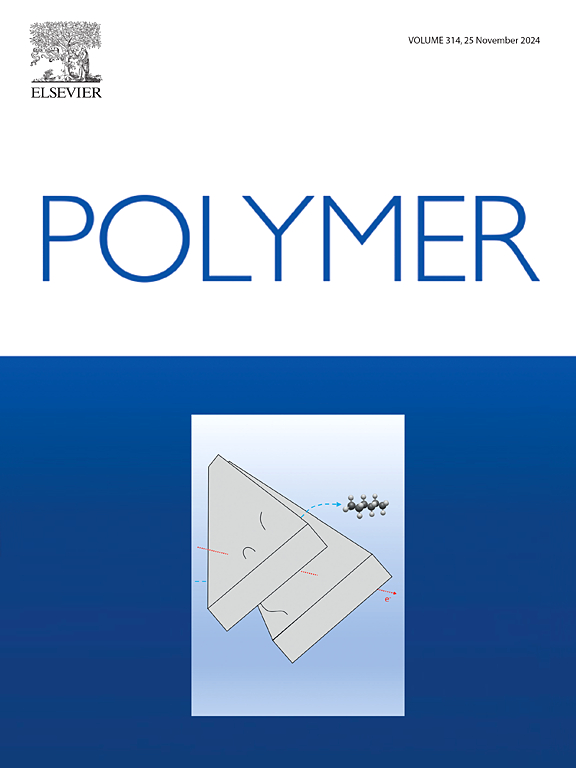Multiple synergies for enhancing the toughening efficiency: toward fully biodegradable polylactide-based engineering plastics with superior toughness, strength and heat resistance
IF 4.1
2区 化学
Q2 POLYMER SCIENCE
引用次数: 0
Abstract
Melt blending with biodegradable poly(butylene adipate-co-terephthalate) (PBAT) is a widely used approach for toughening poly(L-lactide) (PLLA). However, a high PBAT addition (30 wt%) is typically required to achieve supertoughness of PLLA, despite extensive efforts to improve toughening efficiency. Herein, the PLLA/PBAT blends were subjected to a simple one-pot melt blending with an epoxy-functional compatibilizer (ADR) and poly(D-lactide) (PDLA). The enhanced interfacial adhesion resulting from ADR-induced reactive compatibilization, combined with the elevated melt viscosity of the PLLA matrix caused by the generation of stereocomplex (sc) crystallites through PLLA-PDLA interactions, results in a morphological transition from a sea-island to a co-continuous structure. Concurrently, sc crystallites accelerate the PLLA matrix crystallization, achieving a highly crystalline matrix after brief melt crystallization. Owing to the synergistic effects of strong interfacial adhesion, co-continuous structure and highly crystalline matrix, the toughening efficiency of PBAT is markedly enhanced. Consequently, the notched impact strength of PLLA reaches 58.9 kJ/m2 with only 15 wt% PBAT. Additionally, the reduced PBAT content coupled with increased matrix crystallinity endows the blend with high tensile yield strength (57.5 MPa) and heat resistance (Vicat softening temperature up to 156.4 °C). The comprehensive performance of the resulting blend surpasses that of certain commercially available non-biodegradable engineering plastics, potentially expanding the application of fully biodegradable polylactide-based alloys in engineering fields.

增强增韧效率的多重协同作用:向具有优异韧性、强度和耐热性的完全可生物降解聚乳酸基工程塑料方向发展
生物可降解聚己二酸丁二酯(PBAT)熔融共混是一种广泛应用的增韧聚l -丙交酯(PLLA)的方法。然而,尽管在提高增韧效率方面做了大量的努力,但通常需要高PBAT添加量(30% wt%)来实现PLLA的超韧。在此,PLLA/PBAT共混物与环氧功能相容剂(ADR)和聚d -丙交酯(PDLA)进行了简单的一锅熔融共混。adr诱导的反应增容作用增强了界面附着力,再加上PLLA- pdla相互作用产生立体配合物(sc)晶体导致PLLA基体熔体粘度升高,导致从海岛结构到共连续结构的形态转变。同时,sc晶加速了PLLA基体的结晶,在短暂的熔融结晶后获得了高度结晶的基体。由于强界面附着力、共连续结构和高结晶度基体的协同作用,PBAT的增韧效率显著提高。因此,PLLA的缺口冲击强度达到58.9 kJ/m2,只有15%的PBAT。此外,PBAT含量的降低和基体结晶度的增加使共混物具有较高的抗拉屈服强度(57.5 MPa)和耐热性(维卡软化温度可达156.4℃)。由此产生的共混物的综合性能超过了某些市售的不可生物降解的工程塑料,潜在地扩大了完全生物降解的聚乳酸基合金在工程领域的应用。
本文章由计算机程序翻译,如有差异,请以英文原文为准。
求助全文
约1分钟内获得全文
求助全文
来源期刊

Polymer
化学-高分子科学
CiteScore
7.90
自引率
8.70%
发文量
959
审稿时长
32 days
期刊介绍:
Polymer is an interdisciplinary journal dedicated to publishing innovative and significant advances in Polymer Physics, Chemistry and Technology. We welcome submissions on polymer hybrids, nanocomposites, characterisation and self-assembly. Polymer also publishes work on the technological application of polymers in energy and optoelectronics.
The main scope is covered but not limited to the following core areas:
Polymer Materials
Nanocomposites and hybrid nanomaterials
Polymer blends, films, fibres, networks and porous materials
Physical Characterization
Characterisation, modelling and simulation* of molecular and materials properties in bulk, solution, and thin films
Polymer Engineering
Advanced multiscale processing methods
Polymer Synthesis, Modification and Self-assembly
Including designer polymer architectures, mechanisms and kinetics, and supramolecular polymerization
Technological Applications
Polymers for energy generation and storage
Polymer membranes for separation technology
Polymers for opto- and microelectronics.
 求助内容:
求助内容: 应助结果提醒方式:
应助结果提醒方式:


